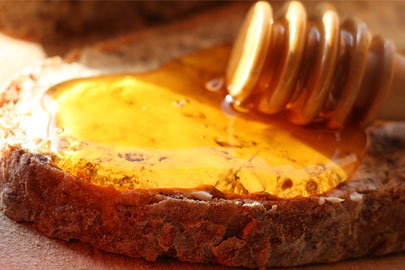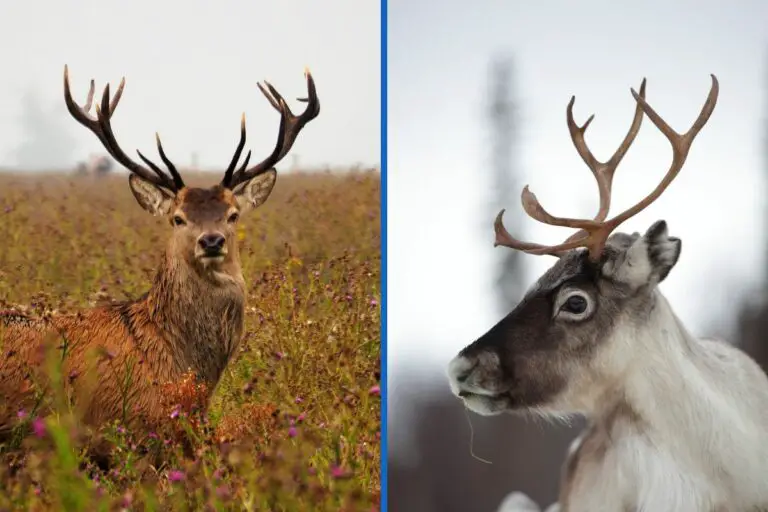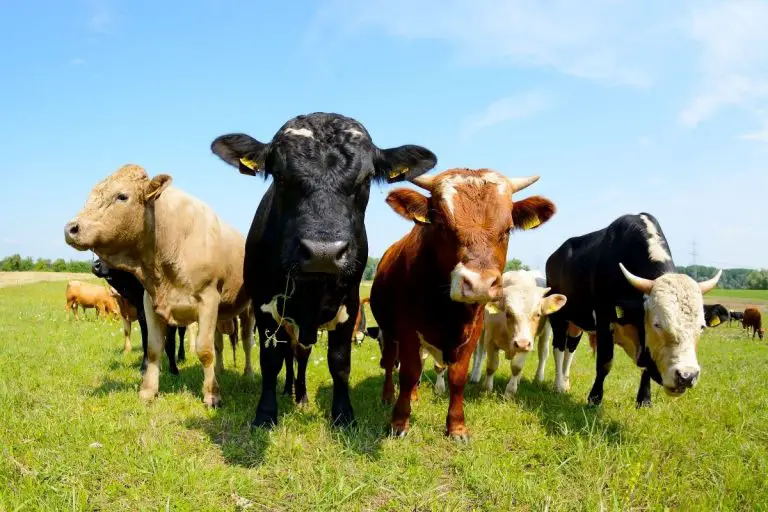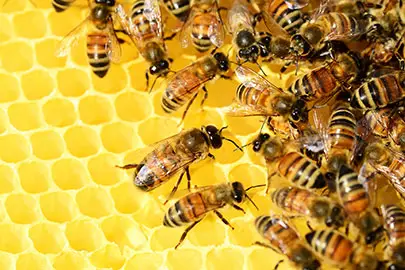What are the Differences between Sheep and Lamb?
Sheep are ruminant mammals usually kept as livestock for the production of meat or wool. But what is a lamb in comparison?
We often use both, but do you know the differences between them?
That’s what we’ll see in this article.
The term sheep can refer to either an adult female, called an ewe, an intact male, called a ram, or a castrated male, called a wether. A lamb is simply a baby sheep of any sex, typically less than a year old.
Here is the short answer, if you want to learn more, keep reading to get all the details.
Sheep
General Characteristics
The sheep that we know today (Ovis aries) are said to be descended from the wild Mouflon of Europe and Asia. Originally, they had a mixture of wool fibers and hair fibers, but as they were domesticated, farmers bred them to be more woolen.
Although different breeds of sheep are bred to have specific purposes, such as wool or milk production, all sheep are generally built the same.

Depending on breed, sheep can be a variety of heights and weights. Typically, though, ewes weigh 100 – 225 pounds, and rams weigh 100 – 350 pounds. They are not particularly large, usually about four to five feet long, and two to four feet tall.
Both wild and domestic sheep can have horns, though many sheep are naturally polled. Domestic sheep live an average of 10 – 12 years, though some may live as old as 20 years.
Behaviors
As is typical of ruminants, sheep spend a lot of their time eating and chewing cud. By the age of four, an adult sheep will have 32 teeth, which will comprise eight incisors in the lower jaw, and molars further back in the mouth, similar to other ruminants. They use their front teeth to tear grasses and weeds from the ground as they graze.
Sheep dislike being alone, as they are incredibly family-driven. A flock is typically made up of a single ram and 35 – 50 ewes, all of whom he is not related to, he will breed with. Adult sheep spend most of their free time lounging and aren’t often playful. However, they may occasionally enjoy pushing a ball around their pasture, or other enriching activities.
Products
As one of the earliest animals to be domesticated for agriculture; textile, leather, meat, and milk products were and still are key reasons to raise sheep.
Wool, which grows from the sheep’s skin is different from hair or fur because it is crimped and elastic. Wool was crucial in earlier civilization as they could create clothing, blankets, tents, coverings for furniture, accessories like hats, and more. Even today, wool may be used to create clothing or blankets, and can be easily found in most craft stores.
Some breeds of sheep, especially those bred for meat, have less wool fibers and more hair fibers similar to the hair of a goat. All sheep have both wool fibers and hair fibers.
Wooled sheep are bred to have predominantly wool, and little hair, and hair sheep are bred to have mostly hair, and little wool. Although this can hair cannot be used as a textile, hair sheep have an advantage in their skin.
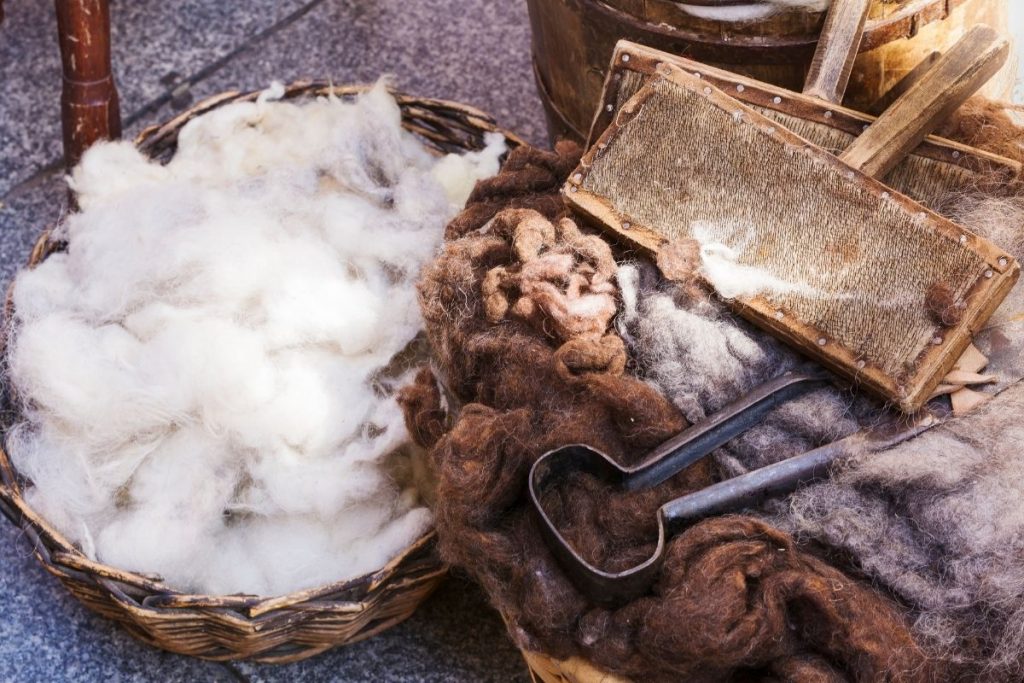
Although all sheep, after being slaughtered and skinned, can be used to make leather, hair sheep’s skin is the best choice. This is because the hair is more coarse and spread out over the body, causing the ‘fiber network’ to be tighter and firmer. In wooled sheep, the many wool fibers are fine and closely packed, making the skin more open and supple. Sheep leather is often used to make book covers, leather accessories, or even furniture.
One of the most common uses for sheep today, is for their meat, which is called mutton. Mutton is very popular in Europe and throughout the Middle East. The meat has a strong flavor, large grain texture, and dark red color. It also has a bit more fat, the amount of which correlates with the age of the sheep.
Another key product from sheep is milk. It is believed that due to their early domestication, sheep were milked long before it became common to milk cows. Today, the practice of milking sheep is most common in Europe and countries surrounding the Mediterranean Sea. The milk itself is rarely consumed, instead it is normally sent to processors to be made into gourmet cheese, yogurts, or ice creams.
Lamb
General Characteristics
Lambs born from a seasoned ewe will normally arrive in mid March, and lambs born from a yearling ewe will arrive roughly three weeks later. Ewes typically birth one to three lambs at a time, with twins being the most common.
They normally weigh five to ten pounds at birth and look like miniature versions of their mothers. Birth size can vary considerably, but lambs are normally the same size as a human newborn, averaging 20 inches in length.
Behaviors
Sleep is critical for most baby animals, and lambs are no exception, sleeping eight to twelve hours each day. In their waking hours, they are very playful, nibbling on things, prancing around, and playing “king of the hill.”

Sheep tend to stick close to each other, and lambs in particular spend a lot of time by their mother’s side. The ewe will teach her lambs the ins and outs of what it means to be a sheep.
Products
For nearly every product which can be created from a sheep, there is a more expensive one created from a lamb.
Lambswool is shorn from a lamb when it is only a few months old. While sheep’s wool is known to be itchy sometimes, lambswool is downy, soft and overall more comfortable. It is also said to be naturally hypoallergenic and resistant to dust mites.
Similarly to the wool, lambskin and the resultant lamb leather are more smooth and soft than those of a sheep. Lamb leather is typically used to make jackets, coats, dresses, and other types of clothes.
Lamb meat, also called lamb, is preferred over mutton in the United States. The meat is mild in flavor, very tender, and a pale pink color. Since the lamb raised for meat is slaughtered at only a few months old, the meat is fine-grained and not fatty.
Opposite to sheep, rather than producing milk, lambs consume it until they are weaned and begin eating grass and other forage. When a female lamb goes through sexual maturation and is an adult, it will be considered an ewe. It would be possible then, after birthing its own lamb or lambs, it will produce milk.
Differences between lamb and sheep
Differences in their Characteristics
The most significant difference in the physical characteristics between sheep and lamb is their size. Lambs are babies, and haven’t had time to grow to the size of an adult sheep. Sheep are usually four to five feet long, whereas a lamb is similar to a human baby, 20 inches long!
Differences in Behaviors
Energy/activity levels is a major difference between sheep and lamb. Sheep are content to chew cud and relax in a comfortable spot when they are not grazing. Lambs, on the other hand, spend half the day sleeping and the other half playing with other lambs.
Differences in Products
The overall differences in the products between sheep and lamb are based on the ‘new-ness’ of the lamb. Since they are significantly younger, the lamb equivalent of each product is positively affected by their young age. The exception to this, is that lambs do not produce milk, and instead consume it.
The wool that comes from sheep has a tendency to be itchy, but generally has many uses. Lambswool, however, is much softer and is even hypoallergenic. Where sheepskin and sheep leather are more tough and are used for things like book covers, lambskin and lamb leather are used for making clothes and apparel since it is smooth and soft.
Following the pattern, lamb is a tender, fine-grained meat with a mild flavor and mutton is a tough, large grained meat with a strong flavor.
Comparison table
| Lamb | Sheep | |
| Characteristics | Weigh 5 – 10 pounds at birth Similar in size to human baby | Ewes weigh 100-225 lbs Rams weigh 100-350 lbs 4-5 ft. long and 2-4 ft. tall |
| Behaviors | Play a lot Sleep 8-12 hours each day | Laidback Like to relax through the day |
| Wool | Much more downy and soft. Hypoallergenic. | Can be itchy or irritating when worn. Used to make blankets, clothes, tents, etc |
| Skin/Leather | Smooth and soft Used to make jackets, coats, and other clothes. | Tough Used to make book covers, accessories, or even furniture |
| Meat | Preferred in the United States Moist, tender, and fine grained. Mild flavor and little fat. Pale pink color | Preferred in Europe and the Middle East. More tough, and large grain textured. Stronger flavor, and some fat. Dark red color |
| Milk | Not capable of producing milk. Consume milk until weaned | Produce milk after birthing lambs |
Conclusion
Although sheep and lamb have many similarities, being the same species, they have many differences. The most significant difference being age influences their physical attributes, behaviors, and the products they produce, all of which set them apart.
References and Resources
Animal Corner. (2020, July 22). Domestic Sheep – Facts, Diet & Habitat Information. Animal Corner. https://animalcorner.org/animals/domestic-sheep/.
AZ Animals Staff. (2021, January 11). Sheep: Incredible Facts, Pictures: A-Z Animals. AZ Animals. https://a-z-animals.com/animals/sheep/.
Cloverworks Farm. (2018, February 1). What Do Sheep Do All Day? Cloverworks Farm. https://cloverworksfarm.com/what-do-sheep-do-all-day/.
Folio3. (2021, January 19). Lamb vs Sheep Comparison: Differences Between Lamb and Sheep. Folio3 Animal Care Practice. https://animalcare.folio3.com/lamb-vs-sheep-comparison/.
Hodakel, B. (2019, June 10). What is Wool Fabric: Properties, How its Made and Where. Sewport. https://sewport.com/fabrics-directory/wool-fabric.
MasterClass. (2020, November 8). What Is Lambswool? Learn the Difference Between Lambswool and Merino Wool – 2021. MasterClass. https://www.masterclass.com/articles/what-is-lambswool#what-is-lambswool.
McCune, K. (2020, April 4). What Are The Differences Between Sheep And Lambs? Family Farm Livestock. https://familyfarmlivestock.com/what-are-the-differences-between-sheep-and-lambs/.
Sheep 101.info. (2017, October 17). “Naked” sheep. Sheep 101: Hair sheep. http://www.sheep101.info/hair.html.
Sheep 101.info. (2020, August 28). Sheep 201: meat, milk, or wool? The purpose of Sheep 101 is to teach students, teachers, 4-H and FFA members, and the general public about sheep, how they are raised, and the contributions to mankind. http://www.sheep101.info/201/meatwoolmilk.html.
Snell, M. (2019, May 19). Wool: The Common Cloth of the Middle Ages. ThoughtCo. https://www.thoughtco.com/wool-the-common-cloth-1788618.

